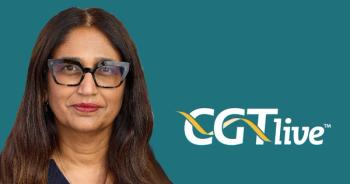
Novel Therapies Reduce the Need for Chemotherapy in Leukemias and Lymphomas
Dipenkumar Modi, MD, discussed novel treatment options in leukemias and lymphomas.
This content originally appeared on our sister site,
Chimeric antigen receptor (CAR) T-cell therapies and other novel therapies such as BTK inhibitors, PI3K inhibitors, and time-limited therapies have transformed the treatment landscape of leukemias and lymphomas and prolonged survival without chemotherapy.
However, there is still more work to be done and additional options are needed, according to Dipenkumar Modi, MD, medical oncologist, Barbara Ann Karmanos Cancer Institute, Wayne State University.
“The therapeutic landscapes for patients with malignant hematologic malignancies are changing. We’ve seen increased efforts, and more novel therapeutic options are being considered. The treatment paradigms are moving toward chemotherapy-free regimens that have shown superior efficacy compared with traditional chemotherapy approaches,” Modi said during an interview with OncLive® during an Institutional Perspectives in Cancer webinar on leukemia and lymphoma.
“[We must] stay tuned to get updated about more agents and, indirectly, to offer the best and most tolerable agents to our patients,” Modi added.
The meeting covered updates in mantle cell lymphoma (MCL), acute lymphoblastic leukemia (ALL), follicular lymphoma, and chronic lymphocytic leukemia (CLL), as well as advances with CAR T-cell therapy in hematologic malignancies overall.
In the interview, Modi, chair of the event, spoke with OncLive about key clinical trials in MCL, ALL, follicular lymphoma, and CLL and highlighted potential future directions, particularly with CAR T-cell therapy, that could fulfill remaining unmet needs.
OncLive®: How has the landscape of MCL changed with the introduction of BTK inhibitors and CAR T-cell therapy? What is next for this paradigm?
Dipenkumar Modi, MD: The therapeutic landscape of MCL has changed significantly. Previously, we were heavily dependent on chemoimmunotherapy, even in the relapsed/refractory setting. However, the therapeutic approaches are moving toward chemotherapy-free regimens.
In relapsed/refractory MCL, we are utilizing BTK inhibitors heavily. Three trials have shown that BTK inhibitors have good safety profiles. One of these trials compared ibrutinib [Imbruvica] with temsirolimus [Torisel], which was [found to be] clearly inferior [vs ibrutinib] in relapsed/refractory MCL.
Moreover, all BTK inhibitors, namely ibrutinib, acalabrutinib [Calquence], and zanubrutinib [Brukinsa], are similar in efficacy; however, they differ in their [toxicity] profiles. The overall response rates [ORRs] with BTK inhibitors are [around] 70%, with complete remission [CR] rates around 20% to 25%. The median progression-free survival [PFS] with those agents is around 14 to 15 months.
Based on this, BTK inhibitors are considered for the first-line treatment of [patients with] relapsed/refractory MCL. Ibrutinib is a first-in-class, nonselective [BTK inhibitor], but it has more off-target activity against EGFR. Therefore, ibrutinib has a different safety profile and pharmacokinetics [than acalabrutinib and zanubrutinib].
[Ibrutinib] is associated with more atrial fibrillation, diarrhea, and low counts compared with acalabrutinib and zanubrutinib, both of which are second-generation BTK inhibitors that have less off-target activity. [The BTK inhibitors] are somewhat different in terms of safety profile. Regardless, whenever we use BTK inhibitors, we must carefully and frequently monitor patients for adverse effects [AEs].
Oftentimes, patients with relapsed/refractory MCL, particularly those with high-risk features such as TP53 mutations, [high] Ki-67, or blastoid morphology, have poor outcomes even with BTK inhibitors. Patients who have high-risk features do not have [substantial] responses with BTK inhibitors; therefore, these are the patients for which we should have a back-up plan ready, which could be CAR T-cell therapy.
Despite having a high-risk group identified by blastoid morphology, high Ki-67, or TP53 mutations, nearly 93% of patients responded [to CAR T-cell therapy in the ZUMA-2 trial (NCT02601313)], and among them 67% had CRs.
As of now, CAR T-cell therapy is promising and should be utilized in patients who relapse after BTK inhibitors [irrespective of] high-risk features.
Of course, promising agents are also coming and have shown promising activity in MCL. One of the most important [novel classes of agents] are the bispecific T-cell engagers [BiTEs]. We reviewed data on epcoritamab and glofitamab, both of which have shown encouraging activity in relapsed/refractory MCL.
Another agent is pirtobrutinib [LOXO-305], which is the most recent BTK inhibitor that has been shown to have good activity with ORRs of 52% in [patients with] MCL [who were previously treated with covalent BTK inhibitors. Pirtobrutinib is different from ibrutinib, acalabrutinib, and zanubrutinib because it is a noncovalent BTK inhibitor, which means it is not dependent on cysteine-281 activity in the BTK receptors. That is how [pirtobrutinib] works even in patients who did not have responses to prior BTK inhibitors.
How have CAR T-cell therapies advanced ALL care?
ALL has a bimodal pattern. It is the most common leukemia seen in children and adolescents; however, we also see a fair proportion of adult patients being diagnosed [with the disease].
Currently, the CAR T-cell therapy tisagenlecleucel [Kymriah] is approved for young adolescent patients up to 25 years [of age with B-cell precursor ALL that is refractory or in second or later relapse]. My guess is that [axi-cel] might soon get approved by the FDA for this indication.
Patients with ALL have some very effective chemotherapy-free regimens [available]; however, it remains to be seen how many of these patients are cured and how many can have durable remissions. We need to see the long-term outcomes of those patients to continue to bring some knowledge to improve outcomes [for these patients].
How may cellular therapies expand follicular lymphoma treatments?
Follicular lymphoma is one of the indolent lymphomas that remains incurable. Many advances have been made in the past few years that have improved outcomes for this high-risk population.
One of the new treatments is CAR T-cell therapy. Most recently, data [from the ZUMA-5 trial (NCT03105336)] were presented at the 2021 ASCO Annual Meeting about axi-cel. The trial showed that the ORR in patients with follicular lymphoma was [over] 90%, and the CR rate was [over] 70%. That treatment has also shown promising results in patients who have progression of disease within 24 months [of starting first-line treatment].
CAR T-cell therapy can be increasingly used in high-risk patients, although it can also replace autologous stem cell transplant in certain instances.
BiTEs or antibodies have shown impressive results [as well]. Those agents are also interesting therapeutic options in the armamentarium of follicular lymphoma. The treatment landscape is increasingly changing, so we might have more agents in the landscape in the next few years.
Could you discuss the utility of CAR T-cell therapy and other newer therapies in CLL? What factors do you consider during treatment selection?
CLL remains another incurable malignancy in which the therapeutic landscape has changed significantly in the past few years. BTK inhibitors have clearly shown superior results compared with chemoimmunotherapy in the treatment-naive and relapsed/refractory settings.
Another [emerging strategy] in CLL is CAR T-cell therapy, which is currently under investigation. At the 2020 ASH Annual Meeting and Exposition, data [from the phase 1/2 TRANSCEND CLL 004 trial (NCT03331198)] were presented [with lisocabtagene maraleucel (Breyanzi)] in combination with ibrutinib in 19 patients with CLL. The combination was associated with a CR rate of [95%]. About [89%] of patients achieved MRD negativity. CAR T-cell therapies are also currently being considered. Although [this agent] is not FDA approved, it is one of the promising agents we might use in the future.
Newsletter
Stay at the forefront of cutting-edge science with CGT—your direct line to expert insights, breakthrough data, and real-time coverage of the latest advancements in cell and gene therapy.











































